Cover photo: María Dolores and her husband in their home just a few steps from Section 6 of the Maya Train. Photo: Santiago Navarro F
Founded by Mayas in the year 415 AD in what is now the state of Quintana Roo, the town of Bacalar was one of the primary centers of Maya resistance against Spanish colonization. Today, the monumental ruins of the ancient Maya city of Ichkabal—the oldest known to date of that civilization—and its Lagoon of Seven Colors, attracts tourists from different parts of the world. These visitors use the hotels and restaurants that surround the lagoon, which provide access only to those who consume the different services.
Just a few kilometers from the tourism hype, the Avispa Midia team moved through small openings in the tropical forest which still survives on the edges of the municipality, looking for the pathway of the Maya Train, the principle megaproject of the government of Andrés Manuel López Obrador. This project “will strengthen the integration of the productive chains in the Yucatán Peninsula,” official government documents argue. It will bring more tourists to the region, regardless of the frequent power outages, the lack of water, and the collapsed drainage systems.
After walking for about fifteen minutes, a large gap appears about 60 meters wide and seemingly infinite in length. On the edges of the gap lies some of the dying vegetation, the rest had already been removed to an unknown location. The gap was filled with a layer of sandy clay packed down multiple times. Everything is ready for the next phase, which is laying down the aggregate, railroad ties, and rails that will carry the train cars across the region.
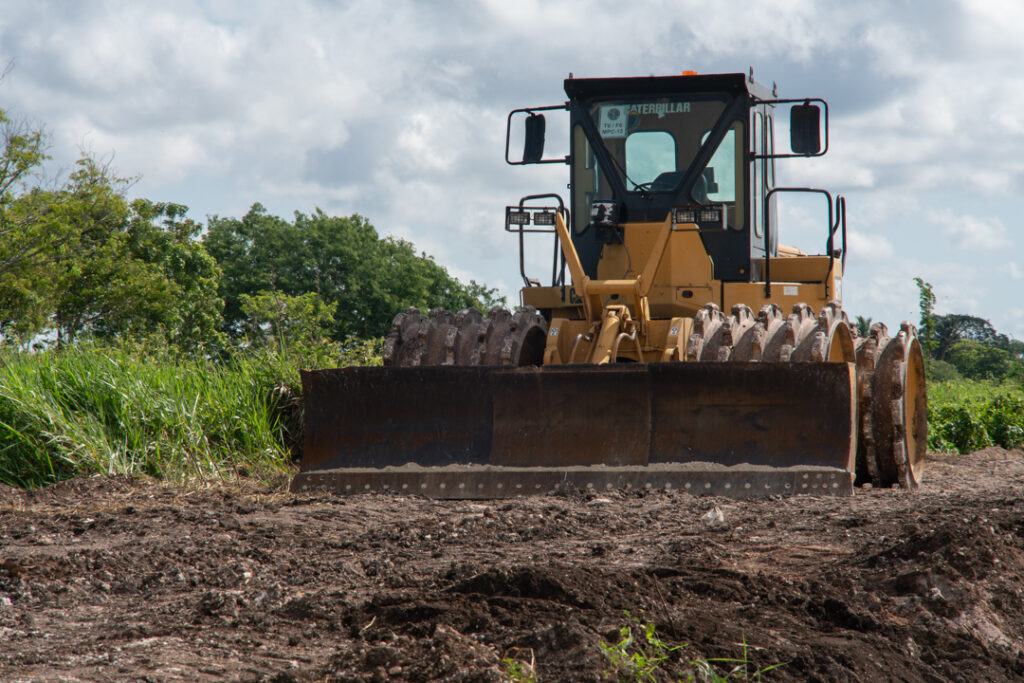
Unexpectedly, along the gap in the tropical forest, appears a humble house blocking the straight line of the forest clearing. The house has survived the coming and going of the heavy machinery that devastated thousands of trees in its path. The house belongs to a 38-year old Maya woman named María Dolores Olvera Chi. There she has lived with her family—her husband and two children—for twelve years.
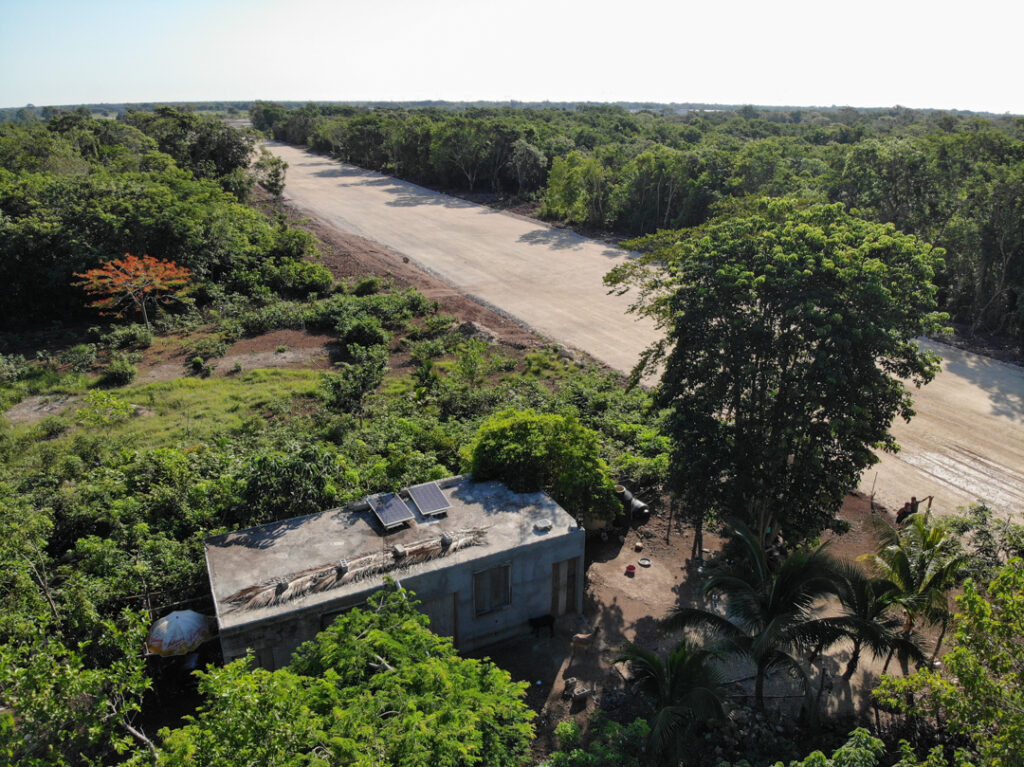
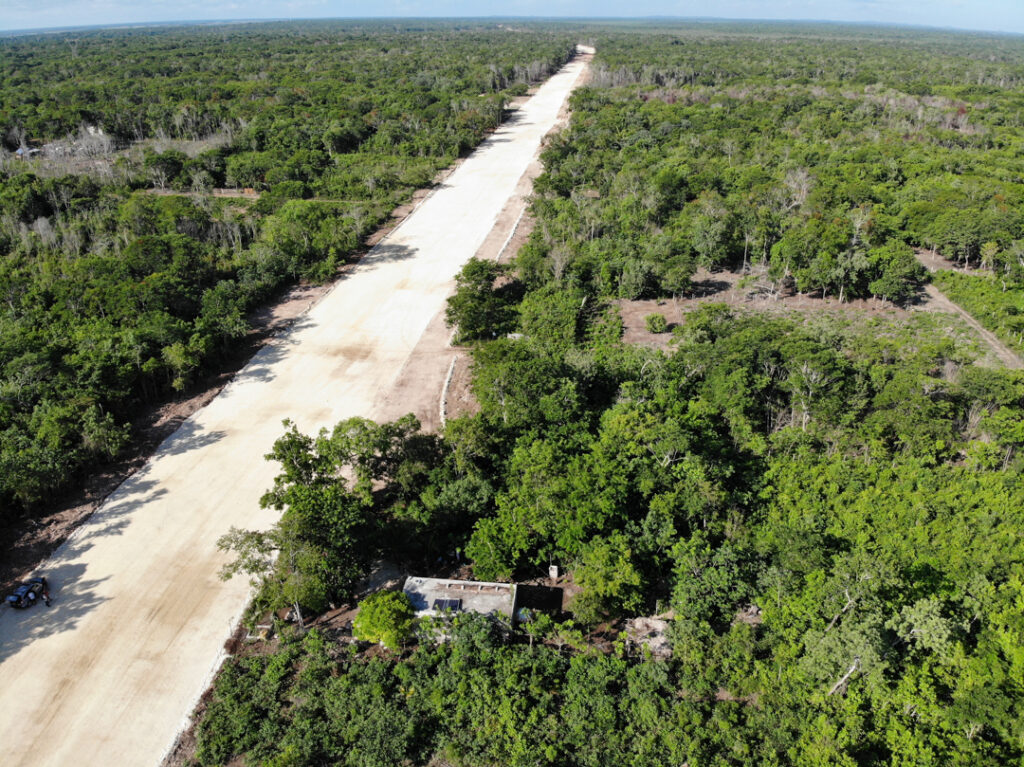
This family’s resistance is what has kept the house standing. “They want to remove us from our home via threats. People come and threaten us so that we leave. They say that they are going to relocate us, that we should take our most important belongings, and that they are going to remove us,” says María to Avispa Midia. She explains that people belonging to the ejido de Bacalar, and others who haven’t identified themselves, are the ones who are intimidating them.
One day after the Avispa Midia team was with María and her husband, men dressed in military uniforms went to their house threatening them again to leave. However, María affirms that she will defend these lands until the last consequences.
Nonetheless, the megaproject advances rapidly. This region contains Section 6 which is scheduled to be ready for operation at the end of 2023. It is one of the three sections of the Maya Train that are beneath the administration of the Secretary of National Defense (SEDENA).
Section 6 of the Maya Train is 250.84 kilometers long with 4.66 kilometers of track connecting with Section 7, totaling 255.50 kilometers between the cities of Tulum and Chetumal in Quintana Roo. The train line is a double track, considered for mixed traffic, passengers, and cargo. The passenger trains will travel at a maximum velocity of 160 kilometers per hour and the cargo trains at a minimum of 85 kilometers per hour. The train will pass through the towns of Nuevo Progreso, Pedro Antonio Santos, Limones, Miguel Hidalgo y Costilla, San Isidro de la Laguna, Buenavista, Caan Lumil, Bacalar, Aarón Merino and Cuauhtémoc, which is the priority region of influence of the railway project.
The project covers an area of 3909.53 acres, according to a study carried out by Greenpeace. This doesn’t consider other related projects, such as vehicular crossings, drainage, camps, storage centers, and substations. The Maya Train, in its seven sections, will cover 1,525 kilometers, and will pass through the states of Chiapas, Tabasco, Campeche, Yucatán, and Quintana Roo.
“Nobody warned us, nobody notified us about the train project. One day, four months ago, we woke up and saw that there were people knocking down the trees. We approached them to ask why they were knocking down the trees and it was then that the people who were working told us that the train was going to pass through here,” remembers María with great sadness.
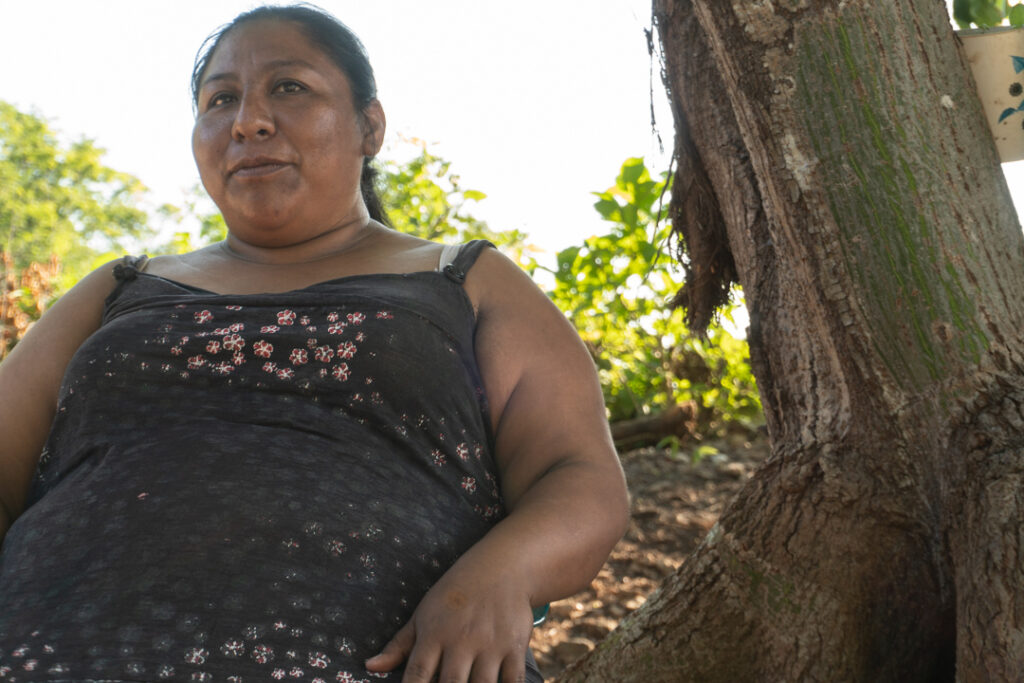
One day, without asking for permission, they arrived to move the fence marking the limit of María’s property. “We left to buy some groceries, and when we returned, they had moved the fence, reducing our land. My husband put the fence up again,” explains the Maya woman. Meanwhile, her neighbors have abandoned their land one by one. “Who knows where they went. We don’t know,” added María.
They work both day and night on the construction of the railway lines. They deforested the entire area. They knocked down everything that was here, scraping the black earth characteristic of the tropical forest, and filling it in with a light-yellow earth, flattening the path. About a kilometer from María’s house is the planned construction of the Bacalar passenger train station.
When María realized the magnitude of the project being developed in front of her house, she immediately went to the offices of the ejido of Bacalar. “We bought ejido lands. We have signed and stamped papers from them (the ejido members). Since we bought directly from them, they have the responsibility to notify us. We have the right to know what was coming,” shares María with anger.
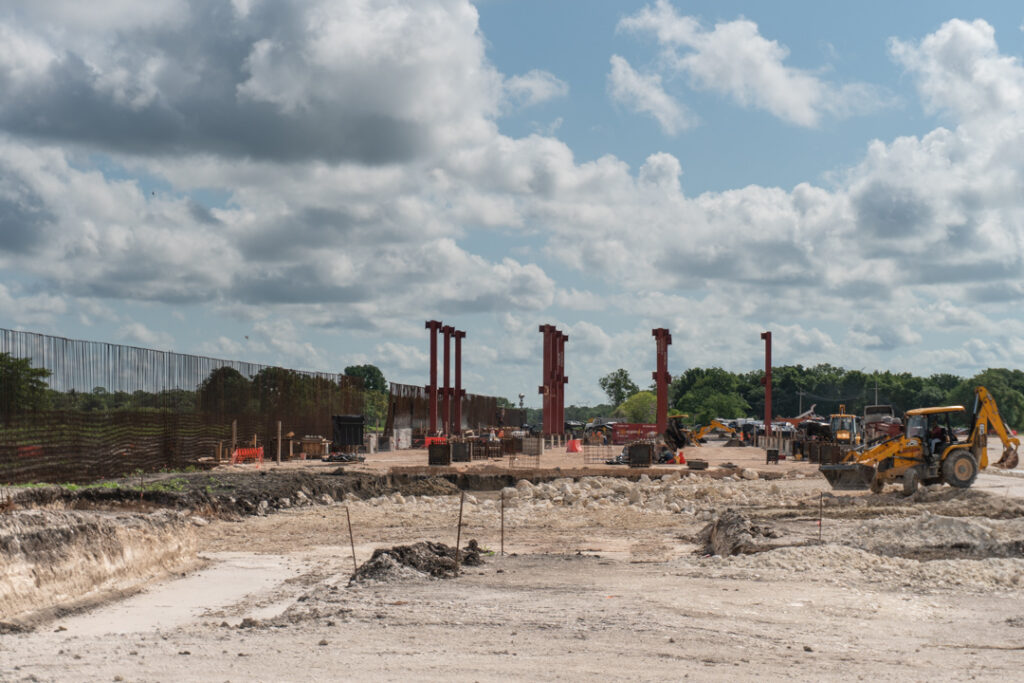

The attempts made by the family for dialogue at the ejido offices have had negative results. “There is no communication. They are closed off to our questions. They aren’t willing to talk with us, they close their doors to us. They give us the run around. They say things, but there is nothing concrete. They treat us with a certain distance,” adds María.
María and her family are not considering leaving their house. “We are firm. We do not want money, nor do we want to go anywhere else. This house is very special to us. We began with nothing. First with the wooden house, then we advanced little by little, struggling. It is very sad to see all of this happening, that suddenly they come and tell you that you have to leave your house.” Furthermore, “they destroyed our trees, they drive away the animals that lived here, like the macaws, the parrots, the deer, and the jaguar.”
Most of the forest that was destroyed is made up of “trees like these,” explains María, pointing to a Ceiba tree that still lives on her patio. It is considered by the Maya people as a divine tree, the tree of life. “It is the tree that connects us to the gods,” she shares with certainty.
Of the 3909.53 acres that make up the project, 92.22% of the land is considered forest. Around 3430 acres are of tropical evergreen forest, 119 acres are tropical lowland evergreen forest, 38 acres are temperate wetlands, and 16.5 acres are mangrove.
What Happened with the Land?
The lands for the project were sold to the federal government by the ejido of Bacalar. They were marked for public utility and expropriated. The decree was published June 26, 2023 in the Official Journal of the Federation, together with four other expropriation decrees in favor of Fonatur Tren Maya SA de CV, affecting lands of five other ejidos in the municipality of Bacalar, and one in the municipality of Othón P. Blanco.
According to the expropriation decree, in a general assembly on July 9, 2022, the 167 ejido members of Bacalar approved to the agreement with Fonatur regarding the common use lands that make up a surface area of around 140 acres.
On September 14, 2022, Fonatur solicited the expropriation via the Secretariat of Agrarian, Territorial and Urban Development (SEDATU) for reasons of public utility.
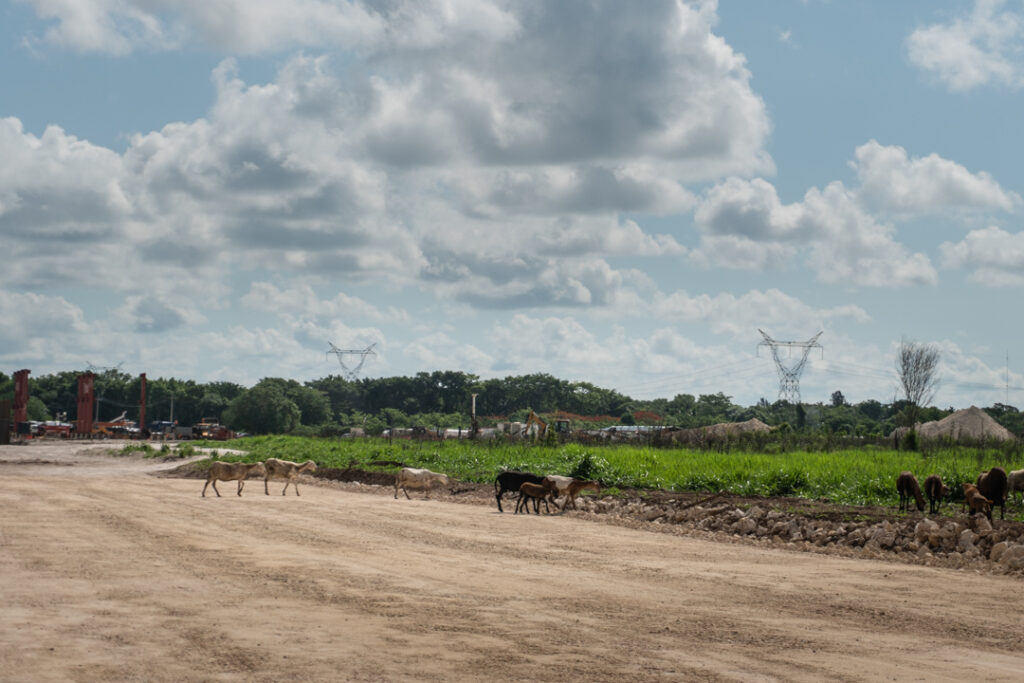

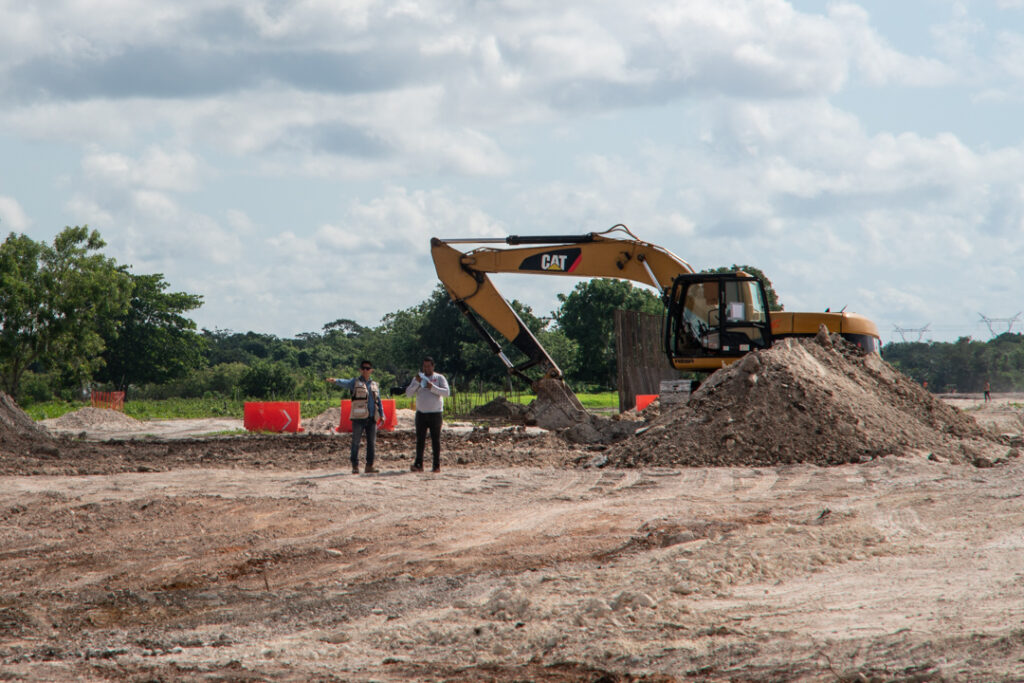
Members of the Ejido Commission of Bacalar notified them on February 11, 2023 regarding the expropriation request and the area which was to be expropriated. According to the document, they had ten business days to “state what was in their best interests.” During that time frame, there was no complaint regarding the project.
On December 21, 2022, the Institute of Administration and Appraisals of National Assets (INDAABIN) emitted an evaluation determining the total amount of compensation based in its commercial value to be $150, 276, 000 pesos (around 8.8 million dollars).
It Goes Because It Goes
The ejido member Luis Chimal Balam, the agrarian authority who led the negotiations with the federal government, told Avispa Midia that the lands have already been paid for. “They paid us what we asked,” he commented.
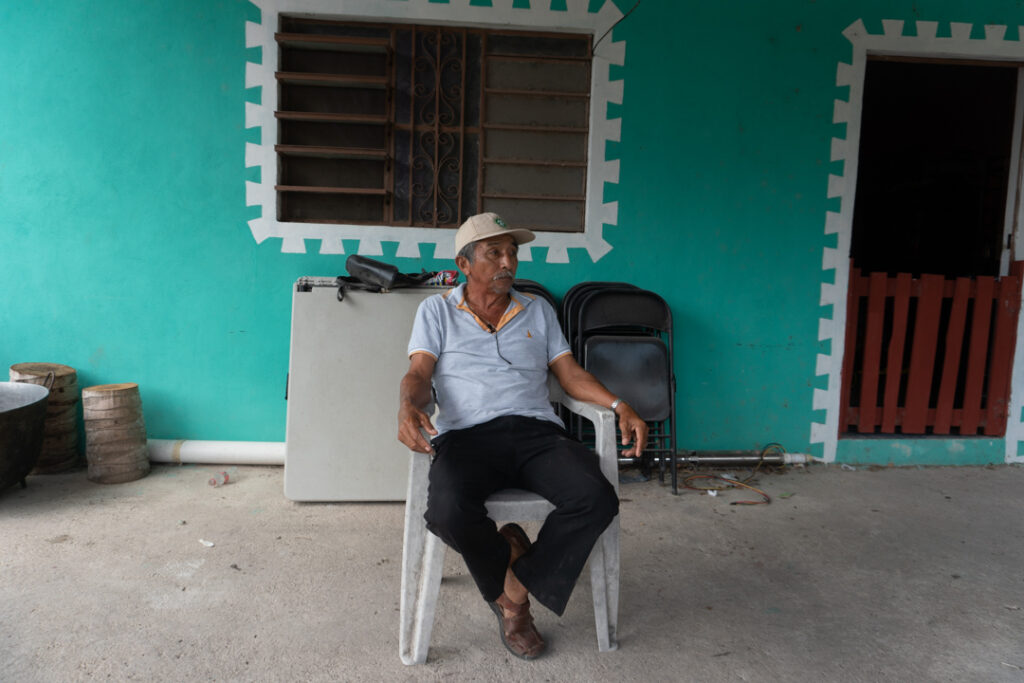
Balam remembers that at the beginning of the negotiations, in 2020, the federal government sent several representatives of different governmental institutions to the ejido. “A lieutenant was even sent to the negotiations. He said to us that they were going to deposit money in the bank for the expropriation. They said to us: when you want to collect it, you can, and if you don’t want to collect it, you don’t have to. The train is going to pass through here, because that’s the way it is,” he remembers.
Then, “we told them that they were wrong, that it was not like that, that they were going to give us what we asked for. You aren’t going to humiliate us just because we are humble people. Make no mistake, we told them.”
Negotiations were carried out in four meetings “until an agreement was reached.”
The ejido member admits that the Maya Train “is not going to benefit us. They told us that it was going to provide jobs to the people in the town, but there was nothing.”
No Agreement
One of the points that the ejido members wanted to negotiate was the resolution of litigation related to 910 acres around the Lagoon of Seven Colors.
In 1971, 910 acres of ejido lands surrounding the lagoon were decreed in favor of the state government. The government sold the land “to politicians and government officials,” privatizing a grand part of the shores of the lagoon. The ejido members have filed lawsuits to recuperate the lands, “but they have received negative resolutions.”
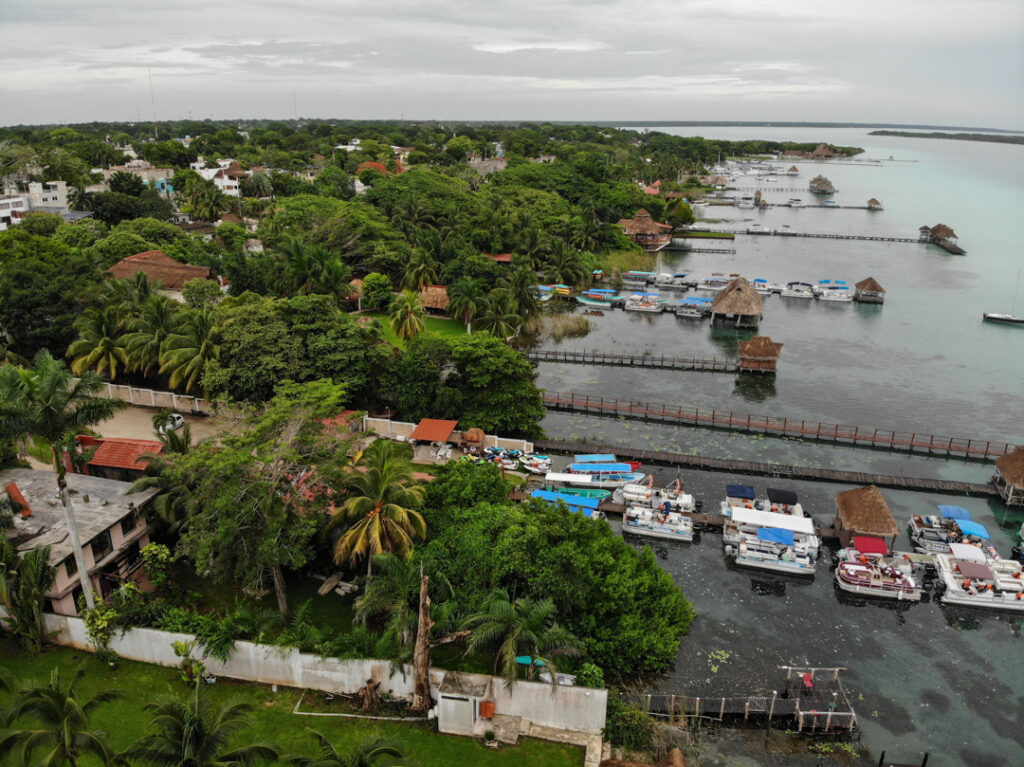
The ejido members filed a lawsuit directly to the federal government. “I have dealt with López Obrador personally, I have taken the files so that justice can be served. Up until now, there has been no resolution in our favor,” claims the ejido member.
The Ejido Doesn’t Represent the Maya People
Aldair T’uut’, member of the Múuch’Xíimbal Assembly –, argues that the right to Maya autonomy and self-determination was not respected in the decisions taken by the 167 ejido members.

“They have their role as ejido members, but they do not represent the Maya territory. They left these decisions to a small handful of people when they truly correspond to the entire Maya community,” he said for Avispa Midia.
He maintained that, “we have been here for millennium, before the constitution existed, before the president existed, before Mexico itself exited. Therefore, we are the ones who must decide.”
Experiences like these have happened throughout the Yucatán Peninsula, says T’uut’. “At best, the federal government approaches with its representatives. We know that the state already has experience in corrupting ejido authorities. They are really good at doing that type of thing. So, when they arrive here, they already have a plan in place where they confront and trick the ejido members. Some want to sell the lands, others don’t. They also play off of the necessity and poverty of the communities.”
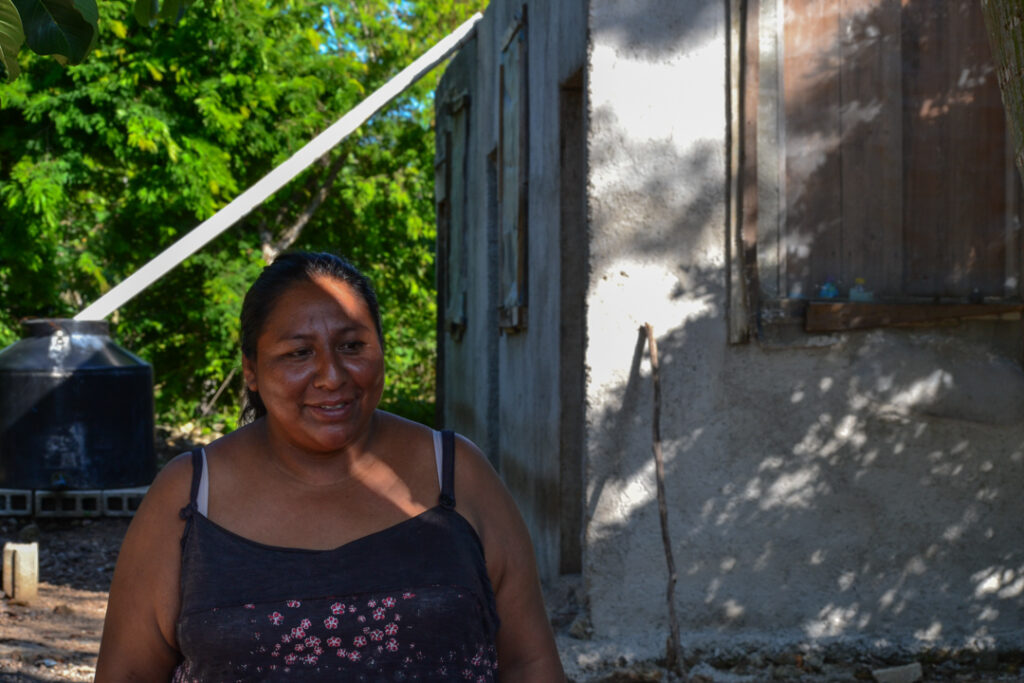
Meanwhile, María and her family, people who do not figure into the negotiations, will end up being displaced and possibly forgotten by the authorities.

